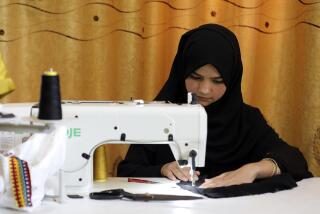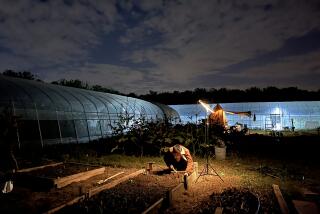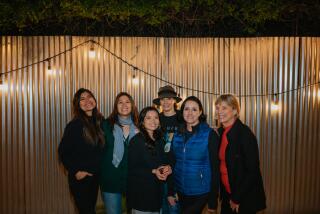Women as Engines Out of Poverty
- Share via
DIEN BIEN PHU, Vietnam — Hoang Thi Mai, a sweet-faced mother of four, removes her rubber thongs and slips fully clothed into a large pond twice a week to do battle for a slippery, wiggling tilapia.
The so-called aquatic chicken, a fish native to Africa with the delicate taste of flounder, will be supper for her extended family of eight in a single-room home of mud and thatch in Vietnam’s verdant northern mountains.
More than a meal, the fat black fish also symbolizes the first step in a solution to one of the globe’s most enduring problems. Hoang has begun the escape from poverty.
From Dien Bien Phu, the town in a misty 12-mile gorge made famous by the final defeat of the French army in 1954, the Vietnamese have launched a new war in dozens of villages. In this conflict, however, the combatants are primarily women.
The tactic is a new frontier in supplying food called aquaculture, or fish farming. Not only is it helping tens of thousands of people worldwide win the battle against constant hunger and disease, it is also providing new stature to women in traditionally male-dominated societies.
Aquaculture is turning an age-old pastime into an occupation thanks to new fish breeds and oral training that circumvents illiteracy or, in the case of Hoang, a member of the Hmong minority, the absence of a formal written language altogether. In one of the most densely populated nations, where 80% of the 75 million population is rural and half lives in poverty, aquaculture also overcomes the shortage of farmland.
Vietnam’s project, launched by the U.N. Development Program in 1994, is not unique. Long bypassed in the development process, women are a centerpiece of a decade-long U.N. campaign, now in its first year, to eradicate poverty worldwide. Innovative U.N. programs include traveling classes for nomadic women in Mongolia’s Gobi desert and political rights seminars for India’s “untouchable” women.
These projects, and others by groups including the U.S. Agency for International Development, or AID, and Save the Children, recognize a global reality: Poverty is sexist. About 70% of the world’s poor are females, according to international aid experts. The number of rural women in poverty grew by almost half between the 1970s and 1990s--to an “awesome” 565 million, reports the International Fund for Agricultural Development.
A major reason, ironically, is the shift to capitalism in many countries that until recently had centrally planned economies.
“The negative impact of economic reform and transition to market economies has tended to hit women harder than men,” reported a 1996 study by the International Labor Organization. The newly free-market economies, for example, have typically concentrated their limited job-training resources on men, the ILO said.
But female-focused development is proving to be more than a response to a new trend. It is providing a more lasting and cost-effective solution to poverty generally.
“Research has repeatedly found that women are more likely than men to use new earnings to solve other problems faced by poor families,” said AID Administrator J. Brian Atwood. “So for development to be effective today, programs must pay attention to the central role of women in the economic and social advancement of a nation.”
Fish Farming Is Ideal
Aquaculture has proved an ideal vehicle. With four of the world’s 17 major fishing areas depleted and five others in serious decline, aquaculture now produces 22% of the world’s food fish, according to the World Bank.
For Vietnam’s Hoang, aquaculture is producing new income after a lifetime of subsistence farming in a rice paddy where her husband still works. Her financial success is reflected in the electricity that, for the first time, illuminates her dirt-floor home and powers a new Samsung black-and-white television. A millenniums-old lifestyle is changing as Hoang’s remote village links up with the modern world.
Progress is also evident in her daughter Thanh, a chubby 3-year-old with overgrown bangs. Like 52% of Vietnamese youth, Hoang’s first two children had their growth stunted by early malnutrition. But Thanh, her youngest, now weighs 30 pounds--the same as the child’s oldest sibling weighed at age 6. Fish has added a source of protein to the rice-based family diet.
The most profound byproduct of aquaculture, however, may be its impact on Hoang’s status. Like other female-focused projects, aquaculture has opened the way for a sweeping challenge to Asia’s patriarchal social order.
“I am now head of this household,” Hoang pronounced as she perched on one of two family stools, her husband and father-in-law listening in deference as they squatted on the floor behind her.
“I took the three-day training. I have the knowledge. So I’m giving the directions,” she said. Hoang was the one who decided last year to sell a family water buffalo, used instead of a tractor in the rice paddy. This year she decided to triple the family’s investment in fish fingerlings to boost production.
“This,” she conceded with a chuckle, “is a huge change.”
The beginning of a social upheaval in Vietnam’s remote mountains can be traced in part to an experiment launched two decades ago in Bangladesh amid widespread skepticism. Its stunning success has since changed the face of development worldwide to emphasize women.
The idea was “micro-credit”--loans of as little as $10 for women to start small businesses based on skills most had or could easily develop. The brainchild of Bangladeshi economics professor Muhammad Yunus, the concept spawned Grameen Bank, whose 1,079 branches have since provided 2.1 million loans, mainly to rural women.
‘Micro-Credit’ Praised
The venture is now being replicated worldwide, usually but not exclusively for women and both in towns and in the countryside. “Micro-credit programs have brought the vibrancy of the market economy to the poorest villages and people. This business approach has allowed millions to work their way out of poverty with dignity,” said World Bank President James D. Wolfensohn.
Little loans for women are now having the biggest impact in alleviating poverty worldwide. Hoang, for example, paid for the first year of fish fingerlings with help from a micro-credit loan facilitated by the U.N. Development Program.
“The key to ending poverty is making use of all things in your life, not just importing new equipment,” said Margaret Carpenter, an assistant AID administrator. “Women are often that key because they can take skills they have or can easily be taught and turn them into extra cash. And that process is begun by offering micro-credit to get started using those skills.”
In the Philippines, micro-credit helped Teresita Mercado convert rags into squatter riches. In her shanty of raw concrete blocks, the stout 52-year-old grandmother with a graying ponytail stitches garment-industry remnants into pads for car washes and shoe covers for factories.
Although she works at home, Mercado is no longer alone. “Micro-entrepreneurs” are moving into a new stage as they form networks, or nascent unions.
In 1993, Save the Children began an experiment in mobilizing some of the 25,000 women in Manila’s rag industry. The goal is to help independents negotiate cheaper textile prices, transport costs and marketing outlets--and to provide a mechanism to sustain their projects once aid sources move on.
Mercado’s net income was $32 a month when she started seven years ago, buying cloth bits on her own and selling products on the street. After she joined a bloc of 1,600 rag workers, her profit rose to $240 monthly, enough to put two of five children through vocational school. One is now an X-ray technician in Saudi Arabia; the other is a pharmacist’s assistant.
Now Mercado is treasurer of the rag group within Women’s Microenterprise Networks, the program spawned by Save the Children. She also now makes more than her husband, Alfredo, a chauffeur in Saudi Arabia for a decade.
“I’ve just asked him to come home,” she said. “Our group can now afford to pay him as a driver to distribute our products.”
Here too the social order has begun to shift.
“I have the power to bargain and suggest in business--and in my family,” Mercado added. “In Filipino culture, the husband is traditionally on top and the wife must follow. But soon I’m going to be his boss.”
Aid experts fully acknowledge a reverse gender bias.
‘Women Are Different’
“Women have a different nature. A woman more often takes advantage of the opportunity to change and makes better use of the transfer of knowledge than a man does. With her, change is usually permanent because change always trickles down through the family,” Yunus explained in his book-lined office at Grameen’s headquarters in Dhaka, the capital of Bangladesh. “Women are the real symbol of development today. Aid to women is making the world a very different place.”
The transformation is tangible in Bangladesh, a country where most women are married between the ages of 12 and 14 to men selected by parents, where Islamic and local traditions restricted women’s movements for centuries, and where more than 50 million people--the majority female--live below the poverty line.
In the village of Boilor, a rough two-hour drive through grassy rice paddies from Dhaka, Jahanara Begum made $9 a month as a seamstress and rice husker for her brothers until 1994. The extended family provided shelter and food. Then she took a $250 loan and training from a U.S. AID-backed aquaculture project.
Today, the 28-year-old divorcee, who was abandoned by her husband, makes $45 a month by growing grass carp in her pond, enough to pay for a tin roof on the family mud-brick home and a bit of land for two brothers to work.
Roles have reversed. “They now defer to me. They wouldn’t make any major decision now without listening to me,” said Begum, wrapped in a saffron sari with red flowers.
Her previous dependent status once virtually guaranteed she would not remarry. Now she has assets--and suitors. “But I’m in no hurry,” she added. “Next time I will marry for love.”
Up to 60% of women in nearby villages are now engaged in aquaculture, some crafting ponds from fallow rice paddies or ditches that fill up during rainy season. Keys to success are simplicity and sustainability, a catchword of aid in the 1990s.
Sustainability means that solutions endure beyond initial funding and training and use low-cost or no-cost local resources. Aquaculture passes the test because animal feces can be used to fertilize pond plant life, which in turn feeds the fish.
A U.S.-backed variation in Bangladesh incorporates a second industry: Chicken droppings fertilize pond plant life, which feeds fish, some of which are ground into meal to feed the chickens. Chicken coops are actually perched above ponds.
Firoja Khatun, a 30-year-old grandmother who looks like a schoolgirl in her yellow cotton smock, giggles at how the aquaculture pond she has run with her daughter since 1994 is changing the balance of power in her home and village.
In past elections, her husband, a mason, told her how to vote--and she unquestioningly obeyed. But in 1996 national elections, during a year when she made more than half the family income, she decided how to cast her ballot. “And he knew better than to ask,” she said.
Female-focused development is not without problems. Vast numbers of women are still reluctant to borrow for fear of consequences at home and in the community if they are unable to repay. Language differences among minorities can put training beyond reach. Model programs such as aquaculture are not applicable everywhere.
As a result, female-focused programs are being adapted and packaged in ways designed to broaden the impact and maximize the audience.
In Dien Bien Phu, women from remote villages gather beneath a white plaster bust of Ho Chi Minh in the drab Women’s Union for three-day seminars on fish farming that cover planning a family as well as a profitable business.
In Bangladesh, three-day training mandated by Women’s Enterprise Development, or WED, a U.S. AID-backed micro-credit office run by and for women that has granted 40,000 small loans since 1987, includes lessons on how to make iodized meals to prevent goiter, a major health problem, as well as on how to keep account logs.
Training techniques are also creating new networks to ensure programs survive after the initial backers leave.
In Vietnam, aquaculture training is done with oral techniques easily passed on even to illiterate women. Women who take the course in Dien Bien Phu are required to train others when they return to their villages.
Thi My, a handsome mother of three, was one of Hoang’s first proteges in Ta Nanh, the mountainside commune where most huts are on stilts.
“During busy times, Hoang may one day help me, and the next I may go to her pond,” Thi said. As they work, the women discuss how and where to market fish as well as whose husbands have been misbehaving.
In Bangladesh, informal female chambers of commerce have taken shape among women borrowers from Women’s Enterprise Development, who must meet every 15 days, both to pay back loans and to take follow-up classes as part of the loan agreement.
Shaheda Khatun and Peara, who like many Bangladeshi women has no surname, are members of a WED group in Dhaka. Khatun used her “micro-loan” to buy bicycle-propelled rickshaws. Her husband drives one of them, and she rents out the other. With advice from the group, she has figured out a way to double the fleet with a second loan as soon as the first is repaid.
Peara used to ask permission of her husband, a truck driver, to leave home; her mother still does not go out in public. But four years ago, Peara took out a WED loan to start a sari business. Today, she takes a bus weekly to garment plants in small towns and brings back saris to sell door to door in Dhaka.
“Cultural restrictions on female mobility are lifting,” Peara said. “I no longer get looks from people questioning my morals because I’m out alone.” Once afraid of handling $12, she now grosses $1,200 a year. On the advice of Khatun, she also recently bought two rickshaws to launch her own fleet.
Male backlash is frequently the chief obstacle to such change. In Vietnam, invitations to women for the pilot U.N. Development Program aquaculture venture in Dien Bien Phu were often accepted instead by their husbands. In Bangladesh, men are angrily questioning why aid is gender-targeted.
Changing Attitudes
“Men are initially very nervous. The average husband doesn’t want the loan, as he fears he’ll have to pay it back,” said Yunus of Grameen Bank. “He also becomes antagonistic when his wife gets the loan, as he thinks he’s being humiliated.”
In Bangladesh and elsewhere, assets such as land titles often have to be transferred to the wife for her to get a micro-loan--making it more difficult for men to walk out of arranged marriages.
Over time, Yunus says, male attitudes are changing.
“Most marital problems emanate from money problems. When a wife no longer nags about income, when she’s busy and contributing, when kids are eating better, when housing improves, husbands usually come around,” he said. “They see that they’re benefiting. It’s an important part of the social transformation that is pivotal to dealing with poverty.”
More to Read
Sign up for Essential California
The most important California stories and recommendations in your inbox every morning.
You may occasionally receive promotional content from the Los Angeles Times.













